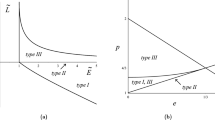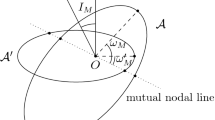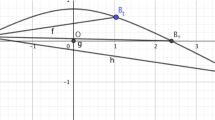Abstract
We consider the Keplerian arcs around a fixed Newtonian center joining two prescribed distinct positions in a prescribed flight time. We prove that putting aside the “opposition case” where infinitely many planes of motion are possible, there are at most two such arcs of each “type.” There is a bilinear quantity that we call b which is in all the cases a good parameter for the Keplerian arcs joining two distinct positions. The flight time satisfies a “variational” differential equation in b, and is a convex function of b.



Similar content being viewed by others
Data Availibility Statement
Data sharing was not applicable to this article as no datasets were generated or analyzed during the current study.
References
Albouy, A.: Lambert’s Theorem: Geometry or Dynamics? Celestial Mechanics and Dynamical Astronomy 131, 40 (2019)
Albouy, A., Ureña, A.J.: Some simple results about the Lambert problem Eur. Phys. J. Special Topics 229, 1405–1417 (2020)
Battin, R.H.: Elegant propositions of the boundary-value problem. Acta Astronautica 15, 965–971 (1987)
Euler, L.: Determinatio orbitae cometae qui mense Martio huius anni 1742 potissimum fuit observatus, Miscellanea Berolinensia, 7, pp. 1–90 (1743)
Euler, L.: Determinatio orbitae cometae qui mense Martio huius anni 1742 potissimum fuit observatus, opera omnia, II28, pp. 28–104
Gauss, K.F.: Theoria Motus Corporum Coelestium in sectionibus conicis solem ambientium, Perthes & Besser, Hamburg (1809); translation by C.H. Davis, Little, Brown & Co, New York (1857); Dover, New York (1963)
Godal, Th.: Conditions of Compatibility of Terminal Positions and Velocities, pp. 40–44. Springer-Verlag, Xlth International Astronautical Congress (1961)
Gooding, R.H.: A procedure for the solution of Lambert’s orbital boundary-value problem. Celestial Mechanics and Dynamical Astronomy 48, 145–165 (1990)
Hénon, M.: Sur les orbites interplanétaires qui rencontrent deux fois la Terre. Bulletin Astronomique 3(3), 377–402 (1968)
Hamilton, W.R.: On a General Method in Dynamics; by which the Study of the Motions of all free Systems of attracting or repelling Points is reduced to the Search and Differentiation of one central Relation, or characteristic Function. Philosophical Transactions of the Royal Society 124, 247–308 (1834)
Hamilton, W.R.: On a General Method in Dynamics; by which the Study of the Motions of all free Systems of attracting or repelling Points is reduced to the Search and Differentiation of one central Relation, or characteristic Function, Math. Papers, vol. 2, pp. 103–161
Jacobi, C.G.J.: Über die Reduction der Integration der partiellen Differentialgleichungen erster Ordnung zwischen irgend einer Zahl Variablen auf die Integration eines einzigen Systemes gewöhnlicher Differentialgleichungen. Journal für die reine und angewandte Mathematik 17, 97–162 (1837)
Jacobi, C.G.J.: Über die Reduction der Integration der partiellen Differentialgleichungen erster Ordnung zwischen irgend einer Zahl Variablen auf die Integration eines einzigen Systemes gewöhnlicher Differentialgleichungen, Werke Bd. 4, pp. 57–127
Jacobi, C.G.J.: Sur la réduction de l’intégration des équations différentielles du premier ordre entre un nombre quelconque de variables à l’intégration d’un seul système d’équations différentielles ordinaires, Journal de mathématiques pures et appliquées, (1) 3, pp. 60–96, 161–201 (1838)
Lambert, J.H.: Insigniores Orbitae Cometarum Proprietates, Augustae Vindelicorum, Augsburg (1761)
Russell, R.P.: Complete Lambert Solver Including Second-Order Sensitivities. Journal of Guidance, Control, and Dynamics 45, 196–212 (2022)
Simó, C.: Solución del problema de Lambert mediante regularización, Collectanea. Mathematica 24, 231–247 (1973)
Acknowledgements
We wish to thank Prof. Giovanni Valsecchi for the reference Hénon (1968). We thank both reviewers for helping us to improve our work.
Author information
Authors and Affiliations
Corresponding author
Ethics declarations
Conflict of interest
The authors declare that they have no conflict of interest concerning the research presented in this work.
Additional information
Publisher's Note
Springer Nature remains neutral with regard to jurisdictional claims in published maps and institutional affiliations.
This article is part of the topical collection on Variational and perturbative methods in Celestial Mechanics.
Guest Editors: Angel Jorba, Susanna Terracini, Gabriella Pinzari and Alessandra Celletti.
Rights and permissions
Springer Nature or its licensor (e.g. a society or other partner) holds exclusive rights to this article under a publishing agreement with the author(s) or other rightsholder(s); author self-archiving of the accepted manuscript version of this article is solely governed by the terms of such publishing agreement and applicable law.
About this article
Cite this article
Albouy, A., Ureña, A.J. How many Keplerian arcs are there between two points of spacetime?. Celest Mech Dyn Astron 135, 18 (2023). https://doi.org/10.1007/s10569-023-10126-7
Received:
Revised:
Accepted:
Published:
DOI: https://doi.org/10.1007/s10569-023-10126-7




